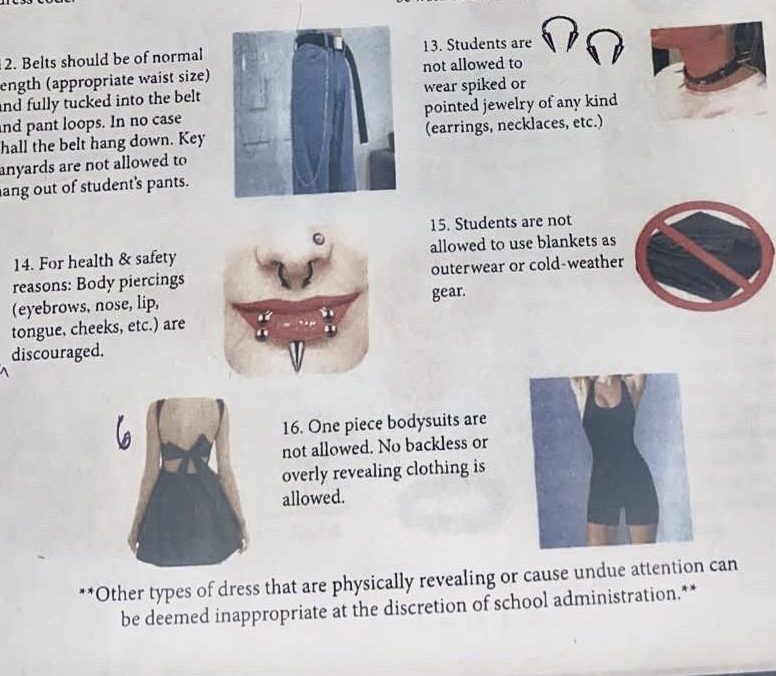
It was a typical Friday morning in September, and the weather was hot. Abby and Gabriela (not their real names) were walking to the finance office to clear a debt. The friends were wearing matching denim mini skirts, which they purposely planned the night before. As they approached the office, a campus monitor in their golf cart stopped them.
“Your skirts look a little short, ladies,” the monitor said. A tape measure was taken out. Indeed, the skirts violated the stated rule: “Skirts need to be 4 inches or less above the knee.” The girls’ skirts were approximately an inch shorter than the stated acceptable length. The girls had no choice but to climb onto the golf cart and be taken to the Shield. Since both of the girls’ parents worked and they had no other clothes to change into, they had to wait in the Shield for someone to bring them a change of clothing. They missed two class periods, while they waited; missing valuable class time before they received clothes. Abby and Gabriela said this experience made them feel angry and violated because they felt their skirts were not inappropriate compared to what other students have worn.
Most school districts in the Central Valley follow a form of dress code, which is for safety, discipline, and the avoidance of unnecessary distractions. The question is, however, when does the dress code begin to breach the line of objectification, sexualization, and double standards? To many, it’s clear that the dress code’s primary targets are often female students, though educators say otherwise. Often, girls walk in the hallways afraid of being stopped for showing their shoulders and midriffs. The dress code has been a part of a student’s life since elementary school, but will it really matter when they’re out of high school?
Student Voices
When it comes to DHS, students are not afraid to say their true thoughts regarding this issue. The female students interviewed believed that the dress code targets them the most. Many of them question the dress code, as they feel that it isn’t always applied to everyone. Many girls recall seeing boys with sagging pants around the halls, but virtually nothing happens to them beyond being told to “pull up your pants.”
On the other hand, the male students interviewed couldn’t care less about the dress code. “I don’t care because I’m not affected,” one male student stated with a shrug. Nonetheless, they all recognized that girls are singled out the most by the campus monitors.
Educators’ Views
Aside from the students’ perspective, it is also important to understand the administrators’ view. The Emperor Grapevine interviewed Mrs. Jones, who works in the Shield and deals with dress code issues daily. She made it very clear that she supports the dress code, as it prepares students for their future endeavors. In her eyes, the way you present yourself amongst your peers in school will translate to the workforce. Regarding student expression, she says, “There are different ways to express yourself, like art or in writing.” As she sees students come in, she notices that the majority sent to the Shield are girls, but she reasons that it’s easier to correct boys than girls. For example, if a boy is caught with sagging pants, it’s easier to correct him than a girl who is wearing a jean skirt that is too short.
Deputy Principal Mr. Contreras acknowledges that clothes are a form of expression, and it’s much harder to find clothes for girls that aren’t too revealing, especially in the summer season. He also explained how hard it is for him to enforce the dress code as a male, as some male teachers feel stereotyped as “creeps” for simply enforcing the dress code upon female students.
“Why are we called pervs when we are just trying to enforce the dress code?” he said, adding that they’re simply trying to do their job.
On the other hand, some staff members don’t agree with all of the dress code rules. One teacher, who did not want their name disclosed, stated that they believe it doesn’t matter if it interferes with the student’s education; they aren’t concerned about what the student chooses to wear. Of course, as an educator, this teacher does understand the need for the dress code, however, they also see how it unfairly affects female students. In addition, for them, their main goal is “to prepare their students for college,” and in college, there isn’t a dress code, so “it seems pointless to them to enforce it.”
One male teacher felt that the dress code does seem to target girls, but with good reason. “Because they show too much of their body,” he said. “It distracts young men. You are here to learn, not to look sexy.”
Mr. Garrison, who is also a part of the school board, believes the answer to the dress code issue is uniforms because “the better dressed you are, the better you behave.”
Many female students see the dress code as a double standard and that administrators turn a blind eye to male students’ violations. To some, the dress code might not be a big deal, but many girls have to deal with the objectification of their bodies simply because they are women. Furthermore, they will think that there is something wrong with the way they present themselves. The current dress code will continue to have a negative impact on our students. This leads to the question: Is the dress code really fair?